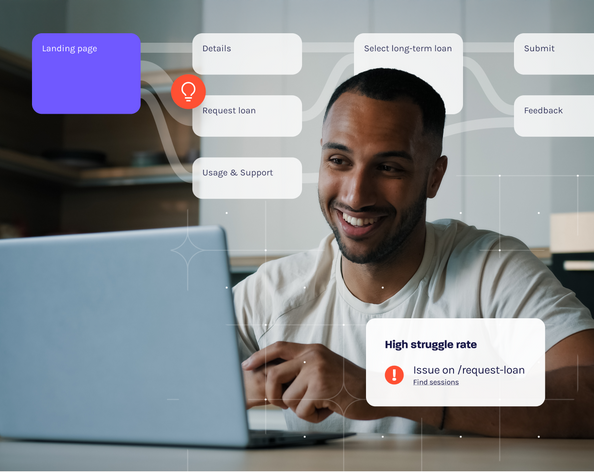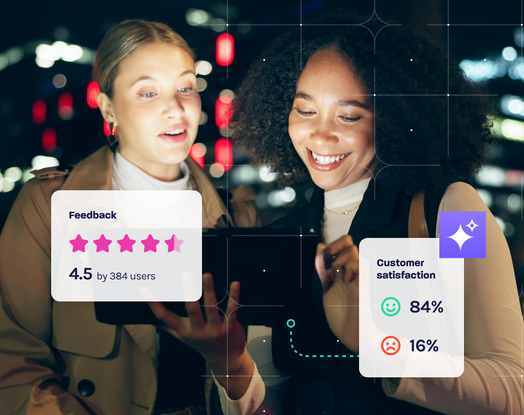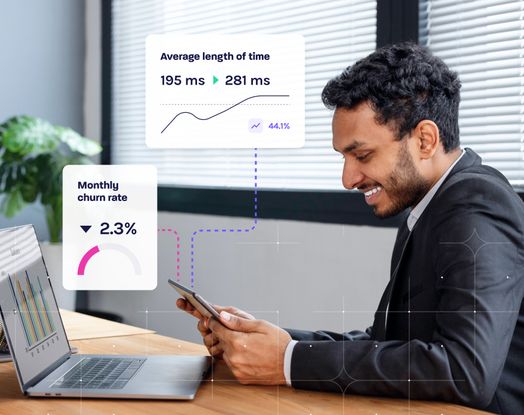
Mastering CX Journey Mapping: 7 Steps to Create a Customer Experience Journey Map
When you visualize every step a potential customer takes, from the moment they first discover your brand to the post-sale follow-up, you gain a panoramic view of the entire customer journey. This is the essence of customer experience journey mapping, which turns a complex sequence of customer touchpoints, emotions and actions into a clear story you can analyze and improve.
By mapping that story, you align customer needs with business goals. The exercise reveals where user expectations intersect with operational objectives, helping you prioritize the changes that drive measurable impact. Teams spot gaps between what customers want and what the business currently delivers, then close those gaps with data-backed solutions.
Closing customer experience gaps is mission-critical. Why? Because modern customers expect seamless digital experiences, real-time personalization and immediate support. A customer journey map is your blueprint to support these expectations while optimizing the entire digital user journey.
Let’s explore exactly how mastering customer experience journey mapping can help your business uncover friction points, unlock growth opportunities and deliver more meaningful digital experiences.
What is Customer Experience Journey Mapping?
Customer experience journey mapping is a structured practice of documenting every customer interaction a person has with your brand, then analyzing those interactions to understand the emotions, motivations and obstacles that shape the outcome. You map the entire customer journey—awareness, consideration, purchase, onboarding, support and advocacy—by cataloging four critical elements at each journey stage:
Customer Touchpoints: The channels and devices customers use to engage, including website, mobile app, live chat or branch visits.
Actions: The specific steps customers take, such as searching for rates or uploading verification documents.
Emotions: The feelings triggered by each interaction, from confidence to frustration.
Pain points: The friction that slows progress, causes abandonment or erodes trust.
When you capture this detail, patterns emerge. For example, a retail investor on a fintech app might hesitate when identity verification fails on mobile, or a corporate treasury manager may abandon a funds-transfer workflow when a hidden field error appears. Whether you serve B2C or B2B audiences, the principle is the same: visualize the journey to reveal where expectations are met or missed.
That clarity translates directly into financial performance. Companies that systematically map customer journeys report higher Net Promoter Scores, reduced churn and stronger customer retention because they allocate resources to the moments that move the needle.
Understanding the discipline of customer journey mapping sets the stage for untangling two related concepts: the customer journey itself and the broader customer experience. Distinguishing between the two will sharpen your optimization efforts and deepen the insights you gain from each experience map.
The Difference Between Customer Journey and Customer Experience
Think of the customer journey as a roadmap and customer experience as the traveler’s feelings along the way. The journey lays out the steps a prospect follows, including researching products, completing applications, receiving confirmations and seeking customer service support. Each step is objective, sequential and verifiable.
Customer experience, by contrast, captures the perceptions those steps create. Speed, clarity and empathy shape whether customer satisfaction or customer frustration is the end result. Two customers can traverse the same journey yet leave with very different impressions based on responsiveness, personalization or perceived effort.
Customer journey mapping bridges these two dimensions by linking concrete customer actions to subjective reactions, then exposing where mismatches occur. For example, users might reach a mortgage calculator in three clicks (an efficient user journey), yet abandon it because confusing terminology erodes trust (a negative experience). Replaying sessions, quantifying struggle and calculating the revenue at stake can help teams see precisely how a single misaligned micro-interaction ripples through the overall customer experience.
When you align the customer journey stages with the emotions it sparks, your optimization efforts become insight-driven rather than guesswork.
Why Customer Journey Mapping Matters
Customers glide across web, mobile and in-app, expecting every customer touchpoint to recognize them, remember their history and anticipate their needs. Meeting that standard is complicated when your channels, data stores and teams operate in silos. Customer journey mapping tools cut through the complexity by providing a single lens on the entire customer experience map, revealing how each customer interaction influences the next.
Personalization, real-time optimization and AI-powered insight are no longer nice-to-haves. They’re table stakes, evidenced by the fact that 90% of businesses have made customer experience their primary focus, and 73% of customers rank CX as the top factor in purchase decisions. Zippia’s analysis further ties these priorities to performance, noting an 80% revenue lift for companies that excel at CX. Customer journey mapping helps you claim that upside by pinpointing exactly where to invest for maximum return.
Glassbox customers frequently see the impact of this clarity. SoFi used customer journey mapping tools to capture 100% of digital sessions, no manual tagging required, and uncovered hidden friction in its loan application flow. Eliminating the issue prevented an estimated $9 million in potential revenue loss and safeguarded customer loyalty and trust. Tagless data capture, AI-driven struggle scores and instant revenue quantification turned a sprawling data set into a focused action plan.
When you combine hard customer data with empathetic insight, you create experiences that can win loyalty in a crowded market.
7 Essential Steps to Create a Customer Experience Journey Map
1. Define Clear Objectives
Begin by aligning stakeholders on what success looks like. Whether you aim to reduce application abandonment, increase cross-sell uptake or improve first-contact resolution, clear objectives guide data collection and keep analysis focused. Establish Key Performance Indicators (KPIs), including conversion rate, time to completion or Net Promoter Score, that quantify progress and create accountability.
2. Identify Customer Personas
Leverage segmentation, CRM profiles and behavioral analytics to build archetypes that reflect real customer needs and motivations. For a bank, that might include a digitally savvy first-time homebuyer and a time-pressed corporate treasurer. Each persona can be further enriched by identifying behavioral clusters drawn from captured sessions, so you see not only who they are but how they actually behave.
3. Analyze All Touchpoints
Create a comprehensive inventory of interactions, including web pages, in-app flows, IVR menus, live chat and even branch visits. Map how customers move between them and note technical dependencies like third-party Application Programming Interfaces (APIs). By combining session replay with digital record keeping, you can capture every click, scroll and behind-the-scenes event for full compliance and forensic detail.
4. Map Emotions, Behaviors and Motivations
Blend quantitative indicators, such as bounce rate, with qualitative sources like Voice of the Customer surveys, verbatim chat logs and sentiment analysis. This reveals where delight turns to frustration, like confusion during document upload or relief when a real-time balance update appears. By humanizing data, you uncover the “why” behind the “what.”
5. Identify Pain Points and Opportunities
Use struggle scores, heatmaps and funnel analysis to identify abandonment, error loops or unnecessary steps. By flagging anomalies and quantifying revenue at risk, you can determine what fixes to prioritize based on ROI. Pain points often double as innovation springboards—streamlining a form, adding proactive chat or surfacing a personalized upsell.
6. Visualize the Journey Using Tools
Translate raw insight into an accessible diagram. Drag-and-drop journey mapping software, augmented by customer journey analytics, can create dynamic maps that update as new data streams in. Simple export options, including PDF, Excel or images, make sharing easy, keeping cross-functional teams aligned on what to fix first.
7. Validate, Share and Iterate With Stakeholders
Present the map to product, marketing, compliance and support teams, then gather feedback to confirm accuracy. Also, be sure to schedule regular reviews so the map evolves with new features, regulations or customer behaviors. If you also implement continuous capture sessions and flag emerging patterns, you can iterate in agile cycles rather than annual overhauls, keeping the journey future-ready.
With a solid grasp of these seven steps, you can choose the map format that best fits your goals.
Types of Customer Journey Maps
Different business goals call for different map formats. Below are three widely used approaches.
Current-State Maps
These diagrams capture the journey exactly as it exists today, highlighting where users succeed and where they struggle. When Credit.com adopted a current-state map, its team quickly discovered a hidden form-field error causing thousands of daily drop-offs. Fixing the flaw, identified through Glassbox’s session replay and path analysis, boosted completed applications and protected valuable advertising spend.
Future-State Maps
Future-state maps envision the ideal experience you intend to deliver. They serve as a blueprint for redesign projects, new product launches or omnichannel rollouts. Visa Cal created a future-state map to streamline its mobile card-activation flow. By modeling the perfect sequence—instant verification, contextual help and biometric login—the issuer prioritized development work that cut activation time by 32 % and drove early card usage.
Day-in-the-Life Maps
While current- and future-state maps center on brand interactions, day-in-the-life maps zoom out to show how customers juggle competing tasks, emotions and channels throughout their day. Banks and insurers use this format to understand how checking balances fit between school drop-offs and conference calls, then tailor micro-experiences, such as push alerts or one-click transfers, that align with real-world context.
Each format offers unique value, and many enterprises maintain two or more simultaneously. Choosing the right one depends on whether you need to uncover hidden friction, chart an aspirational vision or empathize with broader lifestyle patterns.
3 Technologies That Elevate Journey Mapping
1. Journey Analytics
To spot patterns hidden in millions of interactions, you need analytics that scale. Glassbox’s Augmented Journey Map™ layers AI-driven path analysis, chi-square event impact and revenue quantification onto raw session data. The result is instant clarity on which detours cost conversions and which optimizations will pay off fastest. Customer journey analytics provide enterprise-scale insights and help teams filter journeys by persona, device or campaign, prioritize fixes by potential ROI and share insights with every stakeholder.
2. Session Replay and Digital Recordkeeping
Session replay brings each click, tap and API call to life, letting product owners watch friction unfold exactly as customers experienced it. In regulated industries, digital record-keeping ensures every interaction is stored securely for audit and compliance. Coupled with session replay, your team can reproduce errors, validate fixes and confirm that new journeys perform as designed.
3. Voice of the Customer (VoC) Data Integration
Integrating surveys, reviews and chat transcripts adds context to behavioral clues, transforming numbers into narratives. VoC analytics can further turn open-ended feedback into quantifiable drivers you can act on. When a spike in negative sentiment aligns with a newly introduced checkout field, you know exactly where to concentrate your efforts and how to measure success once the issue is resolved.
Harnessing these technologies turns journey maps into living, breathing assets that evolve alongside customer expectations.
Best Practices for Maintaining and Evolving a Journey Map
Longevity and scalability distinguish journey maps that drive lasting value from one-off diagrams that gather dust. Adopt the following habits to keep your maps relevant and your teams aligned.
Treat Maps as Dynamic, not Static
Customer behavior shifts with new regulations, device trends and economic conditions. Schedule quarterly reviews, or faster if you release major features, to refresh data and validate assumptions. Continuous monitoring can flag emerging friction automatically, triggering updates by real user activity rather than arbitrary dates.
Foster Cross-Department Collaboration
Invite compliance, fraud, marketing and customer support to co-own the map. Shared ownership ensures regulatory requirements, brand promises and operational realities all factor into optimization plans. Collaborative exports and live dashboards turn the map into a single source of truth rather than a siloed report.
Use Agile Evolution Powered by Real-Time Insight
By capturing every session, your teams can run A/B tests, deploy fixes and watch results materialize in hours. This agile loop of identify keeps improvements tightly aligned with KPIs and shortens time to value.
Document a Journey Mapping Framework
Following a formal customer journey mapping framework provides structure for discovery, prioritization and measurement. It also streamlines onboarding for new team members and ensures consistency across business units.
By embedding these practices, you can transform journey maps from snapshots into a living navigational system that guides every customer-centric decision.
Ready to Map Your Way to a Better Customer Experience?
Glassbox’s tagless data capture records 100% of user interactions, while AI-powered insights surface the friction points that cost you conversions. Built-in collaboration tools keep every team aligned, so insights turn into action faster. From compliance-grade digital recordkeeping to real-time journey analytics and enterprise-scale session replay, Glassbox gives you one powerful platform to elevate every digital touchpoint.
Curious what hidden friction might be costing you—and how much revenue you could recover? Take a quick platform tour to see how Glassbox can transform your digital customer experience. Then, connect with our experts to map, measure and optimize every step of your customer journey.







